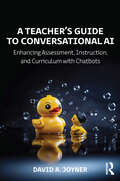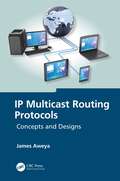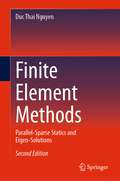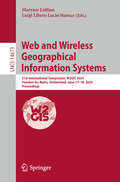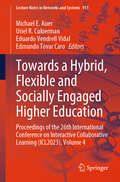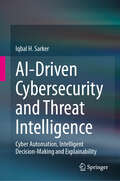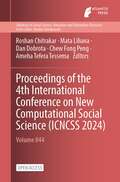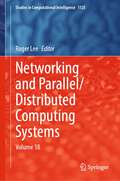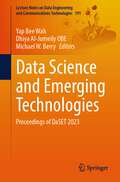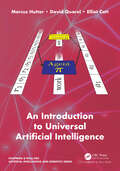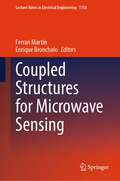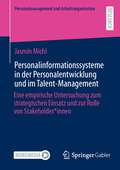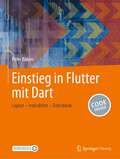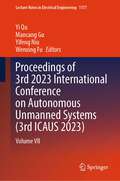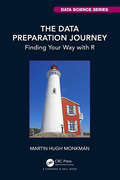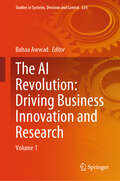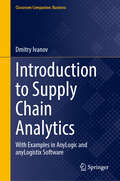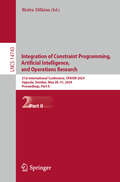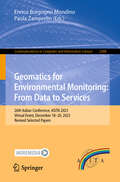- Table View
- List View
A Teacher’s Guide to Conversational AI: Enhancing Assessment, Instruction, and Curriculum with Chatbots
by David A. JoynerA Teacher’s Guide to Conversational AI explores the practical role that language-based artificial intelligence tools play in classroom teaching, learning experiences, and student assessment. Today’s educators are well aware that conversational and generative AI—chatbots, intelligent tutoring systems, large language models, and more—represent a complex new factor in teaching and learning. This introductory primer offers comprehensive, novice-friendly guidance into the challenges and opportunities of incorporating AI into K-12 schools and college classes in ways that are appropriate, nourishing to students, and outcomes-driven.Opening with an informative overview of the foundational properties, key terminology, and ethical considerations of these tools, the book offers a coherent and realistic vision of classrooms that are enhanced, rather than stymied, by AI systems. This includes strategies for:· designing assessments that are conducive to students’ beneficial use of AI while mitigating overreliance or dishonesty;· using AI to generate lesson examples for student critique or custom content that reinforces course principles;· leveraging chatbots as a co-instructor or a tutor, a guide during student-driven learning, a virtual debate or brainstorming partner, and a design project; and· creating course content, lesson plans and activities, expanded language and accessibility options, and beyond. Through the depth of understanding and applied approach provided in these chapters, teachers and leaders in training and in service, alongside private tutors, college instructors, and other educators, will be better prepared to future-proof their efforts to serve new generations of learners.
IP Multicast Routing Protocols: Concepts and Designs
by James AweyaThis book discusses the fundamental concepts that are essential to understanding IP multicast communication. The material covers the well‑known IP multicast routing protocols, along with the rationale behind each protocol. The book starts with the basic building blocks of multicast communications and networks, then progresses into the common multicast group management methods used, and finally into the various, well‑known multicast routing protocols used in today’s networks. IP multicast provides significant benefits to network operators by allowing the delivery of information to multiple receivers simultaneously with less network bandwidth consumption than using unicast transmission. Applications that can benefit greatly from multicast communications and multicast‑enabled networks include audio and video conferencing, collaborative computing, online group learning and training, multimedia broadcasting, multi‑participant online gaming, and stock market trading. This book’s goal is to present the main concepts and applications, allowing readers to develop a better understanding of IP multicast communication. IP Multicast Routing Protocols: Concepts and Designs presents material from a practicing engineer’s perspective, linking theory and fundamental concepts to common industry practices and real‑world examples. The discussion is presented in a simple style to make it comprehensible and appealing to undergraduate‑ and graduate‑level students, research and practicing engineers, scientists, IT personnel, and network engineers. It is geared toward readers who want to understand the concepts and theory of IP multicast routing protocols, yet want these to be tied to clearly illustrated and close‑to‑real‑world example systems and networks.
A Teacher’s Guide to Conversational AI: Enhancing Assessment, Instruction, and Curriculum with Chatbots
by David A. JoynerA Teacher’s Guide to Conversational AI explores the practical role that language-based artificial intelligence tools play in classroom teaching, learning experiences, and student assessment. Today’s educators are well aware that conversational and generative AI—chatbots, intelligent tutoring systems, large language models, and more—represent a complex new factor in teaching and learning. This introductory primer offers comprehensive, novice-friendly guidance into the challenges and opportunities of incorporating AI into K-12 schools and college classes in ways that are appropriate, nourishing to students, and outcomes-driven.Opening with an informative overview of the foundational properties, key terminology, and ethical considerations of these tools, the book offers a coherent and realistic vision of classrooms that are enhanced, rather than stymied, by AI systems. This includes strategies for:· designing assessments that are conducive to students’ beneficial use of AI while mitigating overreliance or dishonesty;· using AI to generate lesson examples for student critique or custom content that reinforces course principles;· leveraging chatbots as a co-instructor or a tutor, a guide during student-driven learning, a virtual debate or brainstorming partner, and a design project; and· creating course content, lesson plans and activities, expanded language and accessibility options, and beyond. Through the depth of understanding and applied approach provided in these chapters, teachers and leaders in training and in service, alongside private tutors, college instructors, and other educators, will be better prepared to future-proof their efforts to serve new generations of learners.
Finite Element Methods: Parallel-Sparse Statics and Eigen-Solutions
by Duc Thai NguyenThis new edition includes three new chapters, 7 through 9, that have very broad, practical applications in engineering and science. In addition, the author’s latest research results incorporated into the new textbook demonstrates better performance than the popular METIS software for partitioning graphs, partitioning finite element meshes, and producing fill-reducing orderings for sparse matrices. The new Chapter 8, and its pre-requisite, Chapter 7, present a state-of-the-art algorithm for computing the shortest paths for real-life (large-scale) transportation networks with minimum computational time. This approach has not yet appeared in any existing textbooks and it could open the doors for other transportation engineering applications. Chapter 9 vastly expands the scope of the previous edition by including sensitivity (gradient) computation and MATLAB’s built-in function “fmincon” for obtaining the optimum (or best) solution for general engineering problems.
Web and Wireless Geographical Information Systems: 21st International Symposium, W2GIS 2024, Yverdon-les-Bains, Switzerland, June 17–18, 2024, Proceedings (Lecture Notes in Computer Science #14673)
by Maryam Lotfian Luigi Libero Lucio StaraceThis book constitutes the refereed proceedings of the 21st International Symposium on Web and Wireless Geographical Information Systems, W2GIS 2024, held in Yverdon-les-Bains, Switzerland, during June 18–19, 2024. The 8 full papers and 7 short papers included in this book were carefully reviewed and selected from 20 submissions. The book also contains one invited talk. They were organized in topical sections as follows: Spatiotemporal Data Analysis, Open Data and Reproducible Research, Geospatial Technologies and Tools, Advanced Computing and GIS Applications, Transportation Applications, and Doctoral Symposium.
Towards a Hybrid, Flexible and Socially Engaged Higher Education: Proceedings of the 26th International Conference on Interactive Collaborative Learning (ICL2023), Volume 4 (Lecture Notes in Networks and Systems #911)
by Michael E. Auer Uriel R. Cukierman Eduardo Vendrell Vidal Edmundo Tovar CaroWe are currently witnessing a significant transformation in the development of education on all levels and especially in post-secondary education. To face these challenges, higher education must find innovative and effective ways to respond in a proper way. The pandemic period left us with profound changes in the way we teach and learn, including the massive use of new means of communication, such as videoconferencing and other technological tools. Moreover, the current explosion of artificial intelligence tools, mainly used by students, is challenging teaching practices maintained for centuries. Scientifically based statements as well as excellent best practice examples are absolutely necessary.The 26th International Conference on Interactive Collaborative Learning (ICL2023), which will take place in Madrid, Spain, between 26th and 30th September 2023, will be the perfect place where to present and discuss current trends in Higher Education.Since its beginning in 1998 this conference is devoted to new approaches in learning with a focus on collaborative learning in Higher Education. Nowadays the ICL conferences are a forum of the exchange of relevant trends and research results as well as the presentation of practical experiences in Learning and Engineering Pedagogy. In this way we try to bridge the gap between ‘pure’ scientific research and the everyday work of educators.
AI-Driven Cybersecurity and Threat Intelligence: Cyber Automation, Intelligent Decision-Making and Explainability
by Iqbal H. SarkerThis book explores the dynamics of how AI (Artificial Intelligence) technology intersects with cybersecurity challenges and threat intelligence as they evolve. Integrating AI into cybersecurity not only offers enhanced defense mechanisms, but this book introduces a paradigm shift illustrating how one conceptualize, detect and mitigate cyber threats. An in-depth exploration of AI-driven solutions is presented, including machine learning algorithms, data science modeling, generative AI modeling, threat intelligence frameworks and Explainable AI (XAI) models. As a roadmap or comprehensive guide to leveraging AI/XAI to defend digital ecosystems against evolving cyber threats, this book provides insights, modeling, real-world applications and research issues. Throughout this journey, the authors discover innovation, challenges, and opportunities. It provides a holistic perspective on the transformative role of AI in securing the digital world.Overall, the useof AI can transform the way one detects, responds and defends against threats, by enabling proactive threat detection, rapid response and adaptive defense mechanisms. AI-driven cybersecurity systems excel at analyzing vast datasets rapidly, identifying patterns that indicate malicious activities, detecting threats in real time as well as conducting predictive analytics for proactive solution. Moreover, AI enhances the ability to detect anomalies, predict potential threats, and respond swiftly, preventing risks from escalated. As cyber threats become increasingly diverse and relentless, incorporating AI/XAI into cybersecurity is not just a choice, but a necessity for improving resilience and staying ahead of ever-changing threats. This book targets advanced-level students in computer science as a secondary textbook. Researchers and industry professionals working in various areas, such as Cyber AI, Explainable and Responsible AI, Human-AI Collaboration, Automation and Intelligent Systems, Adaptive and Robust Security Systems, Cybersecurity Data Science and Data-Driven Decision Making will also find this book useful as reference book.
Big Data Analytics in Astronomy, Science, and Engineering: 11th International Conference on Big Data Analytics, BDA 2023, Aizu, Japan, December 5–7, 2023, Proceedings (Lecture Notes in Computer Science #14516)
by Shelly Sachdeva Yutaka WatanobeThis book constitutes the proceedings of the 11th International Conference on Big Data Analytics in Astronomy, Science, and Engineering, BDA 2023, which took place in Aizu, Japan during December 5–7, 2023. The 19 full papers included in this book were carefully reviewed and selected from 55 submissions. They were organized in topical sections as follows: Data management and visualization; data science: architectures and systems; data science and applications; and cyber systems and information security.
Proceedings of the 4th International Conference on New Computational Social Science (Advances in Social Science, Education and Humanities Research #844)
This is an open access book. Welcome to The 4th International Conference on New Computational Social Science which will be held on March 08-10, 2024, Shenzhen, Guangdong, China. The focus of this conference are mainly five aspects: Big data acquisition and analysis, Integration of qualitative research and quantitative research, Sociological Internet experiment research, Application of ABM simulation method in Sociology Research, Research and development of new social computing tools. With the rapid development of information technology, especially sweeping progress in the Internet of things, cloud computing, social networks, social media and big data. As a data-intensive science, social computing is an emerging thing that leverages the capacity to collect and analyze data with an unprecedented breadth, depth and scale. It represents a new computing paradigm and an interdisciplinary research and application field. A broad comprehension of major topics involved in social computing is important for both scholars and practitioners. This is an international conference on vary research aspects of Computational Social Science. We will present and discuss key concepts and analyze state-of-the-art of the field. The conference not only sheds insights on social computing, but also affords conduit for future research in the field. Social computing has two distinct trends: One is on the social science issues, such as computational social science, computational sociology, social network analysis, etc; The other is on the use of computational techniques, such as social use, hedonic use and generative use. Finally some new challenges ahead are summarized, including interdisciplinary cooperation and training, big data sharing for scientific data mashups, and privacy protect.
Networking and Parallel/Distributed Computing Systems: Volume 18 (Studies in Computational Intelligence #1125)
by Roger LeeThe book reports state-of-the-art results in Software Engineering, Artificial Intelligence, Networking, and Parallel/Distributed Computing in both printed and electronic form. This book presents original papers on both theory and practice that address foundations, state-of-the-art problems and solutions, and crucial challenges.
Data Science and Emerging Technologies: Proceedings of DaSET 2023 (Lecture Notes on Data Engineering and Communications Technologies #191)
by Michael W. Berry Yap Bee Wah Dhiya Al-Jumeily OBEThe book presents selected papers from International Conference on Data Science and Emerging Technologies (DaSET 2023), held online at UNITAR International University, Malaysia during December 4–5, 2023. This book presents current research and applications of data science and emerging technologies. The topics covered are artificial intelligence, big data technology, machine and deep learning, data mining, optimization algorithms, blockchain, Internet of Things (IoT), cloud computing, computer vision, cybersecurity, augmented and virtual reality, cryptography, and statistical learning.
Data Augmentation, Labelling, and Imperfections: Third MICCAI Workshop, DALI 2023, Held in Conjunction with MICCAI 2023, Vancouver, BC, Canada, October 12, 2023, Proceedings (Lecture Notes in Computer Science #14379)
by Chen Chen Chao Chen Yuan Xue Lianrui Zuo Yihao LiuThis LNCS conference volume constitutes the proceedings of the 3rd International Workshop on Data Augmentation, Labeling, and Imperfections (DALI 2023), held on October 12, 2023, in Vancouver, Canada, in conjunction with the 26th International Conference on Medical Image Computing and Computer Assisted Intervention (MICCAI 2023). The 16 full papers together in this volume were carefully reviewed and selected from 23 submissions. The conference fosters a collaborative environment for addressing the critical challenges associated with medical data, particularly focusing on data, labeling, and dealing with data imperfections in the context of medical image analysis.
An Introduction to Universal Artificial Intelligence (Chapman & Hall/CRC Artificial Intelligence and Robotics Series)
by Marcus Hutter David Quarel Elliot CattAn Introduction to Universal Artificial Intelligence provides the formal underpinning of what it means for an agent to act intelligently in an unknown environment. First presented in Universal Algorithmic Intelligence (Hutter, 2000), UAI offers a framework in which virtually all AI problems can be formulated, and a theory of how to solve them. UAI unifies ideas from sequential decision theory, Bayesian inference, and algorithmic information theory to construct AIXI, an optimal reinforcement learning agent that learns to act optimally in unknown environments. AIXI is the theoretical gold standard for intelligent behavior.The book covers both the theoretical and practical aspects of UAI. Bayesian updating can be done efficiently with context tree weighting, and planning can be approximated by sampling with Monte Carlo tree search. It provides algorithms for the reader to implement, and experimental results to compare against. These algorithms are used to approximate AIXI. The book ends with a philosophical discussion of Artificial General Intelligence: Can super-intelligent agents even be constructed? Is it inevitable that they will be constructed, and what are the potential consequences?This text is suitable for late undergraduate students. It provides an extensive chapter to fill in the required mathematics, probability, information, and computability theory background.
Coupled Structures for Microwave Sensing (Lecture Notes in Electrical Engineering #1150)
by Ferran Martín Enrique BronchaloThis book offers a comprehensive and timely review of planar microwave sensors based on coupled structures. Gathering chapters contributed by the most authoritative researchers on this topic, it presents various strategies for sensor performance optimization using coupled lines, directional couplers, and coupled resonators (either distributed or semi-lumped), focusing mainly on sensitivity optimization, and covering chains of coupled resonators as well. The book also reports on analytical methods, design formulas, sensor validation tests, with both simulation and experimental methods, describing some relevant practical applications. Mainly reflecting the research activity carried out by the different contributors in the last years, this book also includes two introductory chapters to help readers who are not very familiar with microwave sensing technologies and coupled structures. All in all, this book addresses advanced graduate students and researchers involved in microwave and sensor technologies, and may be of interest for engineers and professionals as well, working in areas as diverse as wireless sensors and sensor networks, biosensing, chemical sensing, motion control, microfluidics, Internet of Things (IoT), and smart systems.
Personalinformationssysteme in der Personalentwicklung und im Talent-Management: Eine empirische Untersuchung zum strategischen Einsatz und zur Rolle von Stakeholder*innen (Personalmanagement und Arbeitsorganisation)
by Jasmin MichlJasmin Michl realisiert eine tiefgehende Untersuchung zum Einsatz von Personalinformationssystemen in der Personalentwicklung und im Talent-Management mit besonderem Fokus auf strategische Einsatzgebiete und die Rolle von Stakeholder*innen. Im Rahmen ihrer Analyse verbindet die Autorin Perspektiven unterschiedlicher Interessengruppen, um die zentralen Herausforderungen digitaler Einführungsvorhaben im Personalbereich für Unternehmen und ihre Mitarbeitenden herauszuarbeiten. Hierbei wird auf Grundlage eines Mixed-Methods-Ansatzes deutlich, dass die erfolgreiche Bewältigung von technologischen Einführungsprojekten in HR keine rein technische Frage darstellt, sondern vielmehr eine der organisationalen Rahmenbedingungen und der sozialen Transformation. Die Erkenntnisse der Untersuchung bieten einen Einblick in transformationale Bewältigungs- und Positionierungsprobleme von und in Organisationen und bieten eine Grundlage zur Erarbeitung von möglichen Handlungs- und Zielfeldern für die Praxis.
VBA für Office-Automatisierung und Digitalisierung
by Irene WeberVBA bietet das Potenzial, effektive Digitalisierungslösungen mit geringem Aufwand zu realisieren. “VBA für Office-Automatisierung und Digitalisierung" zeigt mit vielen Codebeispielen die Automatisierung von Excel, Word, Outlook, PowerPoint, SAP ERP und SOLIDWORKS und das Zusammenwirken dieser Systeme. Auch Webservices und Rest APIs werden mit VBA angesprochen und erschließen interessante Möglichkeiten bis hin zu KI. Das Buch erläutert wichtige Konzepte und gibt viele Tipps, um VBA-Anwendungen mit einfachen Mitteln unternehmenstauglich und administrierbar zu gestalten.
Einstieg in Flutter mit Dart: Layout – Interaktion – Datenbank
by Peter BühlerDieses Buch vermittelt kompakt und praxisorientiert die wesentlichen Grundlagen von Flutter und Dart. Die Praxismodule, aufgebaut als Schritt-für-Schritt-Anleitungen, sind durchgehend mit Screenshots und Abbildungen illustriert und bieten eine fundierte Basis auch für die weitergehende Arbeit mit Flutter. Dartcodes veranschaulichen ergänzend Wort und Bild der Anleitungen, so kann das Programm durch praktische Arbeit erlernt werden. Die im Buch verwendeten Codedateien stehen zum Download auf GitHub bereit.
Proceedings of 3rd 2023 International Conference on Autonomous Unmanned Systems: Volume VII (Lecture Notes in Electrical Engineering #1177)
by Yi Qu Mancang Gu Yifeng Niu Wenxing FuThis book includes original, peer-reviewed research papers from the 3rd ICAUS 2023, which provides a unique and engaging platform for scientists, engineers and practitioners from all over the world to present and share their most recent research results and innovative ideas. The 3rd ICAUS 2023 aims to stimulate researchers working in areas relevant to intelligent unmanned systems. Topics covered include but are not limited to: Unmanned Aerial/Ground/Surface/Underwater Systems, Robotic, Autonomous Control/Navigation and Positioning/ Architecture, Energy and Task Planning and Effectiveness Evaluation Technologies, Artificial Intelligence Algorithm/Bionic Technology and their Application in Unmanned Systems.The papers presented here share the latest findings in unmanned systems, robotics, automation, intelligent systems, control systems, integrated networks, modelling and simulation. This makes the book a valuable resource for researchers, engineers and students alike.
An Introduction to Universal Artificial Intelligence (Chapman & Hall/CRC Artificial Intelligence and Robotics Series)
by Marcus Hutter David Quarel Elliot CattAn Introduction to Universal Artificial Intelligence provides the formal underpinning of what it means for an agent to act intelligently in an unknown environment. First presented in Universal Algorithmic Intelligence (Hutter, 2000), UAI offers a framework in which virtually all AI problems can be formulated, and a theory of how to solve them. UAI unifies ideas from sequential decision theory, Bayesian inference, and algorithmic information theory to construct AIXI, an optimal reinforcement learning agent that learns to act optimally in unknown environments. AIXI is the theoretical gold standard for intelligent behavior.The book covers both the theoretical and practical aspects of UAI. Bayesian updating can be done efficiently with context tree weighting, and planning can be approximated by sampling with Monte Carlo tree search. It provides algorithms for the reader to implement, and experimental results to compare against. These algorithms are used to approximate AIXI. The book ends with a philosophical discussion of Artificial General Intelligence: Can super-intelligent agents even be constructed? Is it inevitable that they will be constructed, and what are the potential consequences?This text is suitable for late undergraduate students. It provides an extensive chapter to fill in the required mathematics, probability, information, and computability theory background.
The Data Preparation Journey: Finding Your Way with R (Chapman & Hall/CRC Data Science Series)
by Martin Hugh MonkmanThe Data Preparation Journey: Finding Your Way With R introduces the principles of data preparation within in a systematic approach that follows a typical data science or statistical workflow. With that context, readers will work through practical solutions to resolving problems in data using the statistical and data science programming language R. These solutions include examples of complex real-world data, adding greater context and exposing the reader to greater technical challenges. This book focuses on the Import to Tidy to Transform steps. It demonstrates how “Visualise” is an important part of Exploratory Data Analysis, a strategy for identifying potential problems with the data prior to cleaning.This book is designed for readers with a working knowledge of data manipulation functions in R or other programming languages. It is suitable for academics for whom analyzing data is crucial, businesses who make decisions based on the insights gleaned from collecting data from customer interactions, and public servants who use data to inform policy and program decisions. The principles and practices described within The Data Preparation Journey apply regardless of the context.Key Features: Includes R package containing the code and data sets used in the book Comprehensive examples of data preparation from a variety of disciplines Defines the key principles of data preparation, from access to publication
The Data Preparation Journey: Finding Your Way with R (Chapman & Hall/CRC Data Science Series)
by Martin Hugh MonkmanThe Data Preparation Journey: Finding Your Way With R introduces the principles of data preparation within in a systematic approach that follows a typical data science or statistical workflow. With that context, readers will work through practical solutions to resolving problems in data using the statistical and data science programming language R. These solutions include examples of complex real-world data, adding greater context and exposing the reader to greater technical challenges. This book focuses on the Import to Tidy to Transform steps. It demonstrates how “Visualise” is an important part of Exploratory Data Analysis, a strategy for identifying potential problems with the data prior to cleaning.This book is designed for readers with a working knowledge of data manipulation functions in R or other programming languages. It is suitable for academics for whom analyzing data is crucial, businesses who make decisions based on the insights gleaned from collecting data from customer interactions, and public servants who use data to inform policy and program decisions. The principles and practices described within The Data Preparation Journey apply regardless of the context.Key Features: Includes R package containing the code and data sets used in the book Comprehensive examples of data preparation from a variety of disciplines Defines the key principles of data preparation, from access to publication
The AI Revolution: Volume 1 (Studies in Systems, Decision and Control #524)
by Bahaa AwwadThis comprehensive book explores the transformative role of artificial intelligence (AI) in business innovation and research. It provides a solid foundation in AI technologies, such as machine learning, natural language processing, and computer vision, and examines how they reshape business models and revolutionize industries. The book highlights the strategic implications of AI in enhancing customer experience, optimizing operations, and enabling data-driven decision-making. It explores the integration of AI with emerging trends like IoT, blockchain, and cloud computing for innovation. The role of AI in advancing scientific discovery and academic research is also explored, addressing challenges and opportunities in AI-driven methodologies. Organizational and ethical dimensions of AI implementation are considered, including talent acquisition, skills development, and data governance. Real-world case studies showcase AI's transformative power across diverse industries. This forward-thinking guide equips academics, researchers, and business leaders with knowledge and insights to harness the potential of AI and contribute to innovation and research.
Introduction to Supply Chain Analytics: With Examples in AnyLogic and anyLogistix Software (Classroom Companion: Business)
by Dmitry IvanovThe book offers a concise yet comprehensive introduction to supply chain analytics covering management, modeling, and technology perspectives. Designed to accompany the textbook “Global Supply Chain and Operations Management”, it addresses the topics of supply chain analytics in more depth. The book describes descriptive, predictive, and prescriptive supply chain analytics explaining methodologies, illustrating method applications with the use of training exercises, and providing numerous examples in AnyLogic and anyLogistix software. Throughout the book, numerous practical examples and short case studies are given to illustrate theoretical concepts. Along with AnyLogic and anyLogistix model development guidelines and examples, the book has two other distinct features. First, it reviews and explains novel frameworks and concepts related to data-driven decision-making and digital twins. Second, it shows how to use analytics to improve supply chain resilience.Without relying heavily on mathematical derivations, the book offers a structured presentation and explanation of major supply chain analytics techniques and principles in a simple, predictable format to make it easy to understand for students and professionals with both management and engineering backgrounds. Graduate/Ph.D. students and supply chain professionals alike would benefit from a structured and didactically-oriented concise presentation of the concepts, principles, and methods of supply chain analytics. Providing graduate students and supply chain managers with working knowledge of basic and advanced supply chain analytics, this book contributes to improving knowledge-awareness of decision-making in increasingly data-driven and digital environments. The book is supplemented by a companion website offering interactive exercises with the use of AnyLogic and anyLogistix software as well as Spreadsheet Modeling.
Integration of Constraint Programming, Artificial Intelligence, and Operations Research: 21st International Conference, CPAIOR 2024, Uppsala, Sweden, May 28–31, 2024, Proceedings, Part II (Lecture Notes in Computer Science #14743)
by Bistra DilkinaThis book constitutes the proceedings of the 21st International Conference on the Integration of Constraint Programming, Artificial Intelligence, and Operations Research, CPAIOR 2024, held in Uppsala, Sweden, during May 28–31, 2024.The 33 full papers and the 9 short papers presented in the proceedings were carefully reviewed and selected from a total of 104 submissions. The content of the papers focus on new techniques or applications in the area and foster the integration of techniques from different fields dealing with large and complex problems.
Geomatics for Environmental Monitoring: 26th Italian Conference, ASITA 2023, Virtual Event, December 18–20, 2023, Revised Selected Papers (Communications in Computer and Information Science #2088)
by Paola Zamperlin Enrico Borgogno MondinoThis book constitutes the proceedings of the 26th Italian Conference on Geomatics for Environmental Monitoring: From Data to Services, ASITA 2023, which was held as a virtual event during December 18-20, 2023. The 19 full papers included in this book were carefully reviewed and selected from 42 submissions. They were organized in topical sections as follows: Natural hazards monitoring and modelling; technological services for territory planning and Management; methodological advancements in data analysis and processing.
